A shopping cathedral opens for worship
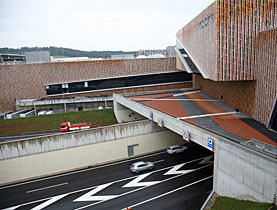
Architect of Berlin's Jewish Museum and master planner of the new World Trade Centre Daniel Libeskind has introduced a new landmark to Bern - a giant shopping centre.
The Westside shopping and leisure centre on the outskirts of the Swiss capital opens its door to the public on Wednesday.
The son of Polish survivors of the Holocaust, Libeskind has been called the world’s most radical architect. He tells swissinfo how Westside aims to bring harmony and purpose to urban sprawl.
The SFr500 million ($438 million) project includes 55 shops, ten restaurants and bars, a hotel, a multiplex cinema, and a spa and leisure pool. Approximately 800 apartments will be built by 2018.
This Westside story begins, somewhat surprisingly, with the Marx Brothers, Libeskind explains.
swissinfo: What came first in the creative process?
Daniel Libeskind: It was a drawing, an image that I had in my mind from the Marx Brothers film the Big Store. And I drew a kind of nexus, connection of different things, of Bern of the site, something of an adventure in shopping.
swissinfo: The complex looks different depending on the vantage point. From the motorway it seems a lot larger than when seen from the city. Which is your favourite vantage point?
D.L.: The building is like a seat for a whole urban development. You can see housing rising, you can see public transport coming here. This is no longer just about a building on a highway. It’s bringing a sustainable, interesting development, a whole community that has an urban character.
Therefore there is not just one angle. Of course there are public spaces that are very dramatic – the swimming facilities, the main piazza, the housing for the elderly, the streets. But I think it’s meant really to be seen in a panoramic way from different angles by different people at different times of the day and night.
swissinfo: This is a public space for daily life. Is it fair to say it is a cathedral for money?
D.L.: I think it’s a cathedral but not for money – for people. Money has always been part of the medieval world as well. Those cathedrals cost a lot of money to build.
We can’t make that kind of separation between the sprit and the material world but I think this place will provide a spirit of something that catches your emotions, your guts, not just for the mind.
swissinfo: During the design and construction, was it important that the site was on the outskirts of the city?
D.L.: Very much so, I wanted to take the idea of irrelevant buildings on the highway, you know these metallic boxes thrown around, and say this is not the right way.
The right way is to use the highway in a positive sense. Make something positive out this conglomerate of sprawl. Bring it together, condense it, create an attraction and a destination where people will not only come and go but really stay and do something and contribute, not just to the economy but to the social life.
swissinfo: How well did you know the city already?
D.L.: I knew Bern very well. I visited Bern many years for its architectural beauties. Every architect should see this incredible city, which is so famous in architectural history, and I knew the landscape here as well because I drove it many times.
swissinfo: Did you find that your creative freedom was curbed by economic restraints?
D.L.: Well I worked very closely with my client. I had a very good client. There was a bold aspiration not to just repeat some sort of formula but to do something new and that was very interesting.
swissinfo: Which of the many competing brands within the centre will emerge as the strongest?
D.L.: I’m not a rigid architect. I’m not one of those architects who does these squares and then says this is the way it has to be, nothing can go in there. It has to be tolerant, just like we have to be in social affairs, we have to accept.
What you see is strong enough to accommodate many different perspectives. That’s what makes a good city. A good city is a city that can incorporate many things and not just exclude things. True cities are evolving; they are not finished. Real cities continue to grow.
swissinfo: There were a lot of objections and problems with this project. Was this also positive for you?
D.L.: I never think opposition is something bad. We live in a democracy. It’s good to have opposition; it’s good to have different points of view. I listen to people and what they say and you learn something good. Of course the building benefits from all the discussions along the way.
swissinfo-interview: Andreas Keiser
The foundation stone for the Westside leisure centre was laid in spring 2007 and structural work was completed in September 2007. At one point it was the largest private construction site in Switzerland.
Westside is situated on the main A1 motorway on the western outskirts of the capital, Bern, and offers 141,500 square metres of usable space.
The Polish-born American architect, artist and set designer was the born in Łódź in 1946.
He studied in Israel and New York and became a US citizen in 1965.
His buildings include the Jewish Museum in Berlin, Germany, the Imperial War Museum North in Manchester, Britain, and the Denver Art Museum in the US.
Libeskind won the competition to be the master plan architect for the reconstruction of the World Trade Centre in Lower Manhattan.
Westside Bern is Libeskind’s first shopping centre and his first project in Switzerland.
“Westside is much more than merely a hulk of a shopping centre. It is a living space of the 21st century. The seamless coexistence of shopping, senior citizens’ residence, hotel and leisure facilities is unique,” said Daniel Libeskind.
Rudolf Kaufmann, guide to Westside building site:
“Light comes through these crystals down to the second basement. It is a new experience every day – the interplay of light and shadow.”
“11,000 tonnes of steel, imagine that. It’s more than they used to build the Eiffel Tower in Paris.”

In compliance with the JTI standards
More: SWI swissinfo.ch certified by the Journalism Trust Initiative
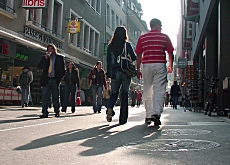
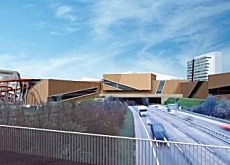
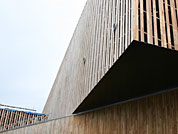
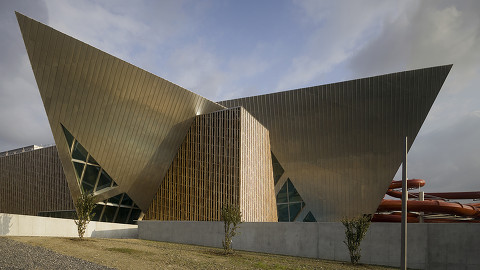
You can find an overview of ongoing debates with our journalists here. Please join us!
If you want to start a conversation about a topic raised in this article or want to report factual errors, email us at english@swissinfo.ch.